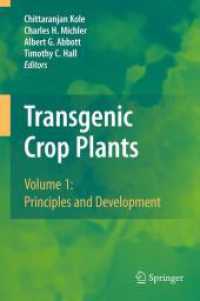- ホーム
- > 洋書
- > 英文書
- > Computer / General
Full Description
Accelerators for Convolutional Neural Networks Comprehensive and thorough resource exploring different types of convolutional neural networks and complementary accelerators
Accelerators for Convolutional Neural Networks provides basic deep learning knowledge and instructive content to build up convolutional neural network (CNN) accelerators for the Internet of things (IoT) and edge computing practitioners, elucidating compressive coding for CNNs, presenting a two-step lossless input feature maps compression method, discussing arithmetic coding -based lossless weights compression method and the design of an associated decoding method, describing contemporary sparse CNNs that consider sparsity in both weights and activation maps, and discussing hardware/software co-design and co-scheduling techniques that can lead to better optimization and utilization of the available hardware resources for CNN acceleration.
The first part of the book provides an overview of CNNs along with the composition and parameters of different contemporary CNN models. Later chapters focus on compressive coding for CNNs and the design of dense CNN accelerators. The book also provides directions for future research and development for CNN accelerators.
Other sample topics covered in Accelerators for Convolutional Neural Networks include:
How to apply arithmetic coding and decoding with range scaling for lossless weight compression for 5-bit CNN weights to deploy CNNs in extremely resource-constrained systems
State-of-the-art research surrounding dense CNN accelerators, which are mostly based on systolic arrays or parallel multiply-accumulate (MAC) arrays
iMAC dense CNN accelerator, which combines image-to-column (im2col) and general matrix multiplication (GEMM) hardware acceleration
Multi-threaded, low-cost, log-based processing element (PE) core, instances of which are stacked in a spatial grid to engender NeuroMAX dense accelerator
Sparse-PE, a multi-threaded and flexible CNN PE core that exploits sparsity in both weights and activation maps, instances of which can be stacked in a spatial grid for engendering sparse CNN accelerators
For researchers in AI, computer vision, computer architecture, and embedded systems, along with graduate and senior undergraduate students in related programs of study, Accelerators for Convolutional Neural Networks is an essential resource to understanding the many facets of the subject and relevant applications.
Contents
About the Authors xiii
Preface xv
Part I Overview 1
1 Introduction 3
1.1 History and Applications 5
1.2 Pitfalls of High-Accuracy DNNs/CNNs 6
1.2.1 Compute and Energy Bottleneck 6
1.2.2 Sparsity Considerations 9
1.3 Chapter Summary 11
2 Overview of Convolutional Neural Networks 13
2.1 Deep Neural Network Architecture 13
2.2 Convolutional Neural Network Architecture 15
2.3 Popular CNN Models 26
2.4 Popular CNN Datasets 30
2.5 CNN Processing Hardware 31
2.6 Chapter Summary 37
Part II Compressive Coding for CNNs 39
3 Contemporary Advances in Compressive Coding for CNNs 41
3.1 Background of Compressive Coding 41
3.2 Compressive Coding for CNNs 43
3.3 Lossy Compression for CNNs 43
3.4 Lossless Compression for CNNs 44
3.5 Recent Advancements in Compressive Coding for CNNs 48
3.6 Chapter Summary 50
4 Lossless Input Feature Map Compression 51
4.1 Two-Step Input Feature Map Compression Technique 52
4.2 Evaluation 55
4.3 Chapter Summary 57
5 Arithmetic Coding and Decoding for 5-Bit CNN Weights 59
5.1 Architecture and Design Overview 60
5.2 Algorithm Overview 63
5.3 Weight Decoding Algorithm 67
5.4 Encoding and Decoding Examples 69
5.5 Evaluation Methodology 74
5.6 Evaluation Results 75
5.7 Chapter Summary 84
Part III Dense CNN Accelerators 85
6 Contemporary Dense CNN Accelerators 87
6.1 Background on Dense CNN Accelerators 87
6.2 Representation of the CNNWeights and Feature Maps in Dense Format 87
6.3 Popular Architectures for Dense CNN Accelerators 89
6.4 Recent Advancements in Dense CNN Accelerators 92
6.5 Chapter Summary 93
7 iMAC: Image-to-Column and General Matrix Multiplication-Based Dense CNN Accelerator 95
7.1 Background and Motivation 95
7.2 Architecture 97
7.3 Implementation 99
7.4 Chapter Summary 100
8 NeuroMAX: A Dense CNN Accelerator 101
8.1 RelatedWork 102
8.2 Log Mapping 103
8.3 Hardware Architecture 105
8.4 Data Flow and Processing 108
8.5 Implementation and Results 118
8.6 Chapter Summary 124
Part IV Sparse CNN Accelerators 125
9 Contemporary Sparse CNN Accelerators 127
9.1 Background of Sparsity in CNN Models 127
9.2 Background of Sparse CNN Accelerators 128
9.3 Recent Advancements in Sparse CNN Accelerators 131
9.4 Chapter Summary 133
10 CNN Accelerator for In Situ Decompression and Convolution of Sparse Input Feature Maps 135
10.1 Overview 135
10.2 Hardware Design Overview 135
10.3 Design Optimization Techniques Utilized in the Hardware Accelerator 140
10.4 FPGA Implementation 141
10.5 Evaluation Results 143
10.6 Chapter Summary 149
11 Sparse-PE: A Sparse CNN Accelerator 151
11.1 RelatedWork 155
11.2 Sparse-PE 156
11.3 Implementation and Results 174
11.4 Chapter Summary 184
12 Phantom: A High-Performance Computational Core for Sparse CNNs 185
12.1 RelatedWork 189
12.2 Phantom 190
12.3 Phantom-2D 201
12.4 Experiments and Results 209
12.5 Chapter Summary 218
Part V HW/SW Co-Design and Co-Scheduling for CNN Acceleration 221
13 State-of-the-Art in HW/SW Co-Design and Co-Scheduling for CNN Acceleration 223
13.1 HW/SW Co-Design 223
13.2 HW/SW Co-Scheduling 228
13.3 Chapter Summary 230
14 Hardware/Software Co-Design for CNN Acceleration 231
14.1 Background of iMAC Accelerator 231
14.2 Software Partition for iMAC Accelerator 232
14.3 Experimental Evaluations 235
14.4 Chapter Summary 237
15 CPU-Accelerator Co-Scheduling for CNN Acceleration 239
15.1 Background and Preliminaries 240
15.2 CNN Acceleration with CPU-Accelerator Co-Scheduling 242
15.3 Experimental Results 251
15.4 Chapter Summary 257
16 Conclusions 259
References 265
Index 285








